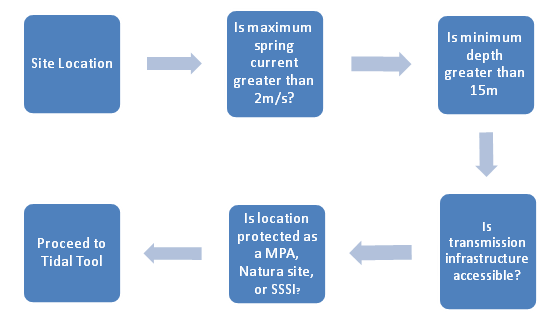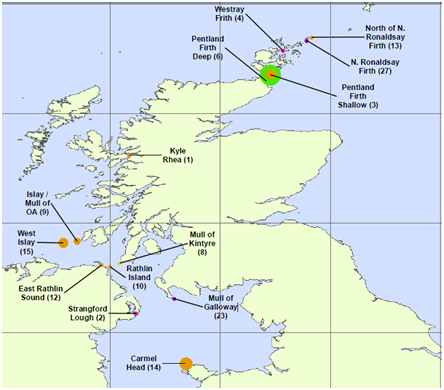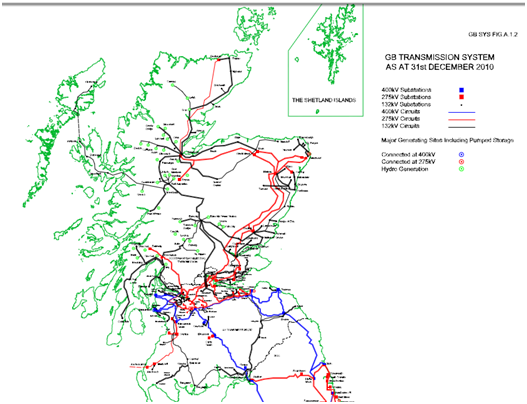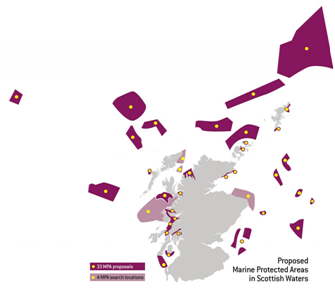Methodology for a Decision Support Tool for a Tidal Stream Device
MSc Sustainable Engineering: Offshore Renewable Energy


Site Selection
Environmental evaluations play a unique and active role within the field of marine renewable feasibility studies. The condition and properties of the local environment will directly relate to engineering challenges, financial feasibility, and the overall design process of the project. Therefore environmental analysis must be positioned as a key component of feasibility studies and continue in this manner through detailed design.
Within a decision support tool for the scoping of tidal stream turbines the environmental conditions will dictate the resource potential, consent likelihood of the project, and the resulting turbine design in a variety of ways. Therefore this discussion focuses on the above aspects.
The results of the investigation highlighted three key areas that influence the project site location at this early scoping stage: resource, grid infrastructure, and local ecology. The basis of the environmental scoping methodology is shown in the following block flow diagram:

Environmental Scoping Methodology
Resource Potential
It is important to adhere to some general principles when evaluating a tidal site. The key criteria can affect the financial viability of the turbine:
• 2-3m/s maximum spring peak current
• Minimum depth of 15m to seabed at lowest astronomical tide to provide space for the device
• As close to the coast as possible to minimise transmission costs
These criteria mean that channels and constrictions between two land masses provide the best site because of the resultant faster flow velocities. Large headlands that do not interfere with the flow, estuaries, and narrow entrances to lakes can also be suitable sites [2]. From these suitable sites it can be seen that the islands off the west and north coast of Scotland will be the most suitable for selection. The following is a snapshot of potential sites around Scotland outlined by the Carbon Trust [3].

Potential Sites around Scotland – Carbon Trust
The surface speed and depth of a chosen site can then be found and if it adheres to the assessment criteria, the site would be worth further analysis. A database of tidal surface speeds and depth can be found in various nautical almanacs. For this investigation Reeds Nautical Almanac was used for reference [4].
Grid Connection
Proximity to the grid is an essential consideration for scoping feasibility studies. This is a particular problem because areas of great tidal resource are often in remote areas with weak transmission infrastructure [5]. Therefore transporting the energy to a paying customer becomes very difficult and hugely expensive (estimates of costs of overhead lines are in the region of £2.2m - £4.2m per kilometre [6]). It hugely is important that this infrastructure exists or is in development for any marine project.
Due to the political push for greater renewable generation in the grid both District Network Operators (DNO) in Scotland - SHE Transmission in the highlands & Islands, SP Energy Networks in the central belt – are planning extensive upgrades and important reinforcements in strategic locations for the grid. The details of these proposals can be found at the links:
Scottish and Southern Energy: Major Transmission Porject Update October 2013
Scottish Power Energy Networks: Transmission Business Plan

GB Transmission System as at 31st December 2010 [7]
Ecology
Within a scoping assessment of a proposed tidal site the possibility of planning consent is an important consideration. This can prevent the loss of important resources by investing a more detailed design stage in a project that can practically be implemented. Within Scotland there are certain areas that can be wholly avoided whereby submitting a planning request would be a difficult process and likely a fruitless endeavour. These include: Marine Protected Areas (MPAs), Special Areas of Conservation (SAC), Special Protection Areas (SPAs), and Sites of Special Scientific Interest (SSSI).
A searchable database created by Scottish National Heritage can be used to check the status of the propose site in terms of enforced or proposed protection. This can be found at the following link:
Scottish National Heritage: Protected Areas across Scotland
For more information on each protection system, please refer to the appropriate section:
Marine Protected Areas
Marine Protected Areas were introduced to the maritime industry in Scotland following the Marine (Scotland) Act. The legislation was then established for the executive to introduce a network of areas designed to conserve a variety of marine species and habitats as well as regions of “geodiversity”. The purpose of the policy was to shelter these regions of the sea from human activity to allow them the opportunity to return to a sustainable and healthy condition [8]. Therefore these areas should be well avoided in the scoping of a tidal turbine development (there is similar legislation in the rest of the UK). Additionally MPAs can extend from the application in the natural environment to protect regions of marine cultural heritage.
Currently there are 33 proposed MPAs [9] and an additional 4 remain to be assessed, which if all deployed would represent 11% of the total area of Scotland’s seas according to government statistics [8].

Proposed Marine Protected Areas in Scottish Waters - Sharing the Sea [Evans, Neil]
Natura Site - Special Areas of Conservation
SACs were introduced following the EU Habitat Directive whereby it provided the framework to identify and protect regions of biodiversity of European importance. In terms of the marine environment this translates as coral reef habitats, bottlenose dolphins, and grey/harbour seals [10]. There are currently 46 SACs around the seas of Scotland [11].
Natura Site - Special Protection Areas
Under the EU birds directive the European Parliament introduced SPAs with the aim of protecting wild birds and their habitats. The government can now classify areas which protect scarce and vulnerable birds in Europe, including migratory species. This involves taking steps to avoid pollution, degradation, and any significant disturbances within the area [12]. There are currently 45 marine Special Protection Areas (SPAs) protecting seabirds such as puffins and kittiwakes [11].
Sites of Special Scientific Interest
SSSIs are implemented under domestic legislation of the Wildlife and Countryside Act 1981. This allows the Government to protect areas of flora, fauna, and geological features of national importance against damaging processes [12]. There are currently 188 SSSIs protecting habitats and biodiversity around Scotland’s seas, of these 61 overlap with areas proposed in the MPA framework [8].
References:
➙ [2] Thake, Jeremy. Development, installation, and testing of a large-scale tidal current turbine. Department of Trade
& Industry (DTI). 2005.
➙ [3] Black & Veatch. Main Potential Tidal Power Sites. Appendix A: UK Tidal Current Resource & Economics - UK Maps.
The Carbon Trust, 2011.
➙ [4] Bloomsbury Publishing . Reeds Nautical Almanac. 2013.
➙ [5] Steiner-Dicks, K. Grid connections for tidal power a “tricky issue”. Tidal Today. Nov 2011.
➙ [6] Parsons Brinckerhoff. Electricity Transmission Costing Study. Institutution of Engineering & Technology (IET).
2012.
➙ [7] National Electricity Transmission System. Seven Year Statement, Apendix A. May 2011.
➙ [8] Scottish Government, Marine. Planning Scotland’s Seas: 2013 Possible Nature Conservation Marine Protected
Areas Consultation Overview. 2013.
➙ [9] Scottish Natural Heritage. Marine SACs. Protecting Scotland's Nature. July 2013.
➙ [10] Scottish Government. Marine Protected Areas. April 2014.
➙ [11] Royal Society for the Protection of Birds. A brief guide to nature designations. Sept 2004.